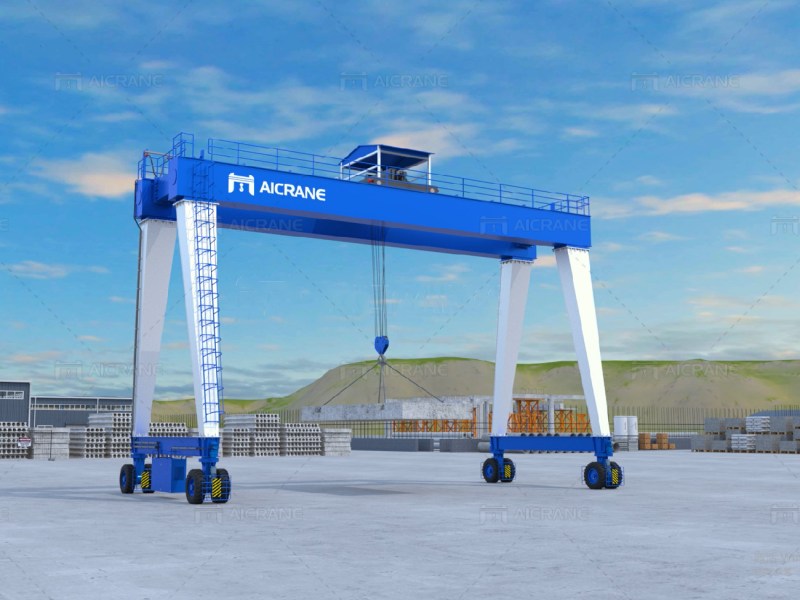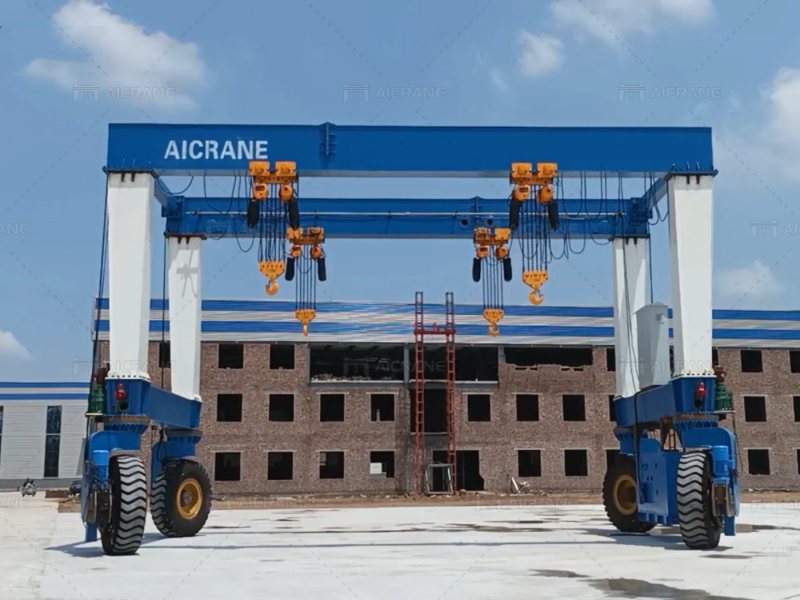In the realm of material handling and logistics, efficiency and adaptability are paramount. To meet the ever-evolving demands of various industries, equipment must possess a combination of versatility and power. Rubber-tyred gantry (RTG) cranes are exemplary in this regard, offering a remarkable fusion of flexibility and strength. In this article, we will explore the versatility and power of rubber-tyred gantry cranes and their significance in modern industrial operations.
Rubber-tyred gantry cranes, often referred to as RTG cranes, are mobile cranes used for the handling of containers and other heavy loads in container yards, intermodal terminals, and ports. They derive their name from the rubber tires that enable their mobility, making them capable of moving independently within a predefined area. This mobility sets rubber tyred gantry cranes apart from stationary gantry cranes, offering a host of benefits for a variety of applications.

Key Features of Rubber Tyred Gantry Crane
- Mobility: The rubber tires of RTG cranes allow them to move horizontally, making them highly mobile within a container yard or terminal. They can be easily repositioned to access different stacks of containers.
- Versatility: RTG cranes are adaptable to different container sizes and types, offering flexibility in container handling. They can straddle multiple lanes and rows of containers.
- Precise Control: Modern RTG cranes are equipped with advanced control systems, providing operators with precise control over lifting, lowering, and horizontal movements.
- Efficiency: Their mobility and ability to handle containers with precision contribute to high operational efficiency, reducing handling times and improving yard management.
- Container Stacking: RTG cranes can stack containers vertically, making optimal use of available yard space.
- Environmentally Friendly: Many RTG cranes are designed to operate on electricity, reducing emissions and minimizing the environmental impact.
The Versatility of Rubber Gantry Cranes
RTG cranes are renowned for their adaptability and can be effectively employed in various industrial applications. Some of the key areas where their versatility shines include:
- Container Terminals: RTG cranes are commonly found in container terminals where they handle the movement of shipping containers. They are used for unloading containers from trucks, stacking them in the yard, and loading them onto other transport modes, such as ships or trains. The ability to straddle multiple rows and lanes of containers makes them ideal for managing large terminal operations efficiently.
- Intermodal Yards: In intermodal facilities, RTG cranes are instrumental in the transfer of containers between different modes of transport, such as ships, trains, and trucks. Their flexibility and mobility allow for smooth and efficient cargo transfer.
- Port Facilities: Ports rely on RTG cranes for the handling of containers, both for import and export operations. These crane machines are crucial in ensuring that ships are loaded and unloaded efficiently to minimize port turnaround times.
- Industrial Warehouses: RTG cranes can be used in large industrial warehouses and distribution centers for the handling of heavy and oversized cargo. Their adaptability makes them suitable for a range of storage and retrieval tasks.
- Construction Sites: In construction applications, RTG cranes are used for transporting and placing materials like steel beams, concrete elements, and pre-fabricated structures. Their precision control and ability to reach different points on the site make them valuable tools for construction projects.
The Power of Rubber Tire Cranes
RTG cranes are known for their robust and powerful capabilities. The strength of RTG cranes is exemplified by several key attributes:
- Lifting Capacity: RTG cranes typically have high lifting capacities, ranging from 30 ton to 100 tons or even more. This substantial lifting power allows them to handle heavy containers and large cargo with ease.
- Durability: RTG cranes are built to withstand the rigors of continuous and heavy-duty operation. They are constructed with high-strength materials and components to ensure durability and reliability.
- Stability: The wide rubber tires and the design of RTG cranes provide excellent stability, even when lifting heavy loads. This stability is essential for safe and secure container handling.
- Adaptation to Rough Terrain: Some RTG cranes are equipped with features that allow them to operate on rough or uneven terrain. This makes them suitable for various environments and outdoor applications.
- Advanced Technology: Modern RTG cranes incorporate state-of-the-art technology, such as automation, remote control, and data analytics, to enhance their performance and efficiency.
Significance in Modern Industrial Operations
RTG cranes have a significant impact on modern industrial operations, enhancing productivity, efficiency, and safety. Their contribution to various industries and applications is undeniable:
Improved Yard Management
In container terminals and intermodal yards, RTG cranes streamline yard management by providing precise control and efficient stacking of containers. This results in reduced container handling times and optimized use of yard space.
Faster Turnaround Times
Ports and terminals benefit from RTG cranes by reducing the time it takes to load and unload containers from ships. This, in turn, leads to faster turnaround times for vessels and improved port efficiency.
Enhanced Safety
The precision control and advanced safety features of RTG cranes contribute to a safer work environment, reducing the risk of accidents and damage to cargo.
Versatile Handling
The adaptability of RTG cranes allows industries to handle various types of cargo, including containers, heavy machinery, and construction materials, making them valuable assets in diverse applications.
Environmental Responsibility
Many modern RTG cranes are designed to operate on electricity, reducing emissions and the environmental impact. This aligns with the growing emphasis on sustainability and green technology in industrial operations.
Technological Advancements
The power and versatility of RTG cranes have been further enhanced by technological advancements. Some notable innovations include:
- Automation: Automation has made RTG cranes more efficient and accurate in container handling. Automated RTG systems can optimize container stacking and retrieval, reducing human error and increasing productivity.
- Remote Operation: Some RTG cranes can be operated remotely from a control center, improving safety and operator comfort. Remote operation also allows for the management of multiple cranes simultaneously.
- IoT Integration: The integration of Internet of Things (IoT) sensors and data analytics enables the monitoring of crane performance and predictive maintenance, minimizing downtime and maintenance costs.
- Electrification: As part of the green technology movement, RTG cranes are increasingly being electrified to reduce emissions and energy consumption. This shift towards cleaner energy sources aligns with environmental responsibility.
The power and versatility of rubber-tyred gantry cranes have made them invaluable assets in various industrial applications. Their adaptability, robust lifting capabilities, and technological advancements have significantly enhanced modern industrial operations. Whether it’s handling containers in ports, transferring cargo in intermodal yards, or supporting construction projects, RTG cranes continue to play a vital role in shaping the efficiency and effectiveness of material handling and logistics in today’s fast-paced industrial world.
